Charles M. Kozierok The TCP-IP Guide
Подождите немного. Документ загружается.


The TCP/IP Guide - Version 3.0 (Contents) ` 811 _ © 2001-2005 Charles M. Kozierok. All Rights Reserved.
Ultimately, the entire point of having networks, internetworks and protocols suites like TCP/
IP is to enable networking applications. Most Internet users employ these applications on a
daily basis. In fact, most of us will be running many different applications simultaneously.
For example, you might be using a World Wide Web browser to check the news, an FTP
client to upload some pictures to share with family, and an Internet Relay Chat program to
discuss something with a friend or colleague. In fact, it is common to have multiple
instances of a single application. The most common example is having multiple Web
browser windows open (I sometimes find myself with as many as 30 going at one time!)
Multiplexing and Demultiplexing
Most communication in TCP/IP takes the form of exchanges of information between a
program running on one device, and a matching program on another device. Each instance
of an application represents a copy of that application software that needs to send and
receive information. These application instances are commonly called processes. A TCP/IP
application process is any piece of networking software that sends and receives information
using the TCP/IP protocol suite. This includes both “classic” end-user applications such as
the ones described above, as well as support protocols that behave as applications when
they send messages. Examples of the latter would include a network management protocol
like SNMP, or even the routing protocol BGP (which sends messages using TCP like an
application does).
So, a typical TCP/IP host has multiple processes each needing to send and receive
datagrams. All of them, however, must be sent using the same interface to the internetwork,
using the IP layer. This means that the data from all applications (with some possible
exceptions) is “funneled down”, initially to the transport layer, where it is handled by either
TCP or UDP. From there, messages pass to the device's IP layer, where they are packaged
in IP datagrams and sent out over the internetwork to different destinations. The technical
term for this is multiplexing. This term simply means combining, and its use here is a
software analog to the way it is done with signals.
A complementary mechanism is responsible for receipt of datagrams. At the same time that
the IP layer multiplexes datagrams from many application processes to be sent out, it
receives many datagrams that are intended for different processes. The IP layer must take
this stream of unrelated datagrams, and eventually pass them to the correct process
(through the transport layer protocol above it). This is the reverse of multiplexing:
demulti-
plexing. You can see an illustration of the basic concept behind TCP/IP process
multiplexing and demultiplexing in Figure 197.
Key Concept: TCP/IP is designed to allow many different applications to send and
receive data simultaneously using the same Internet Protocol software on a given
device. To accomplish this it is necessary to multiplex transmitted data from many
sources as it is passed down to the IP layer. As a stream of IP datagrams is received, it is
demultiplexed and the appropriate data passed to each application software instance on the
receiving host.
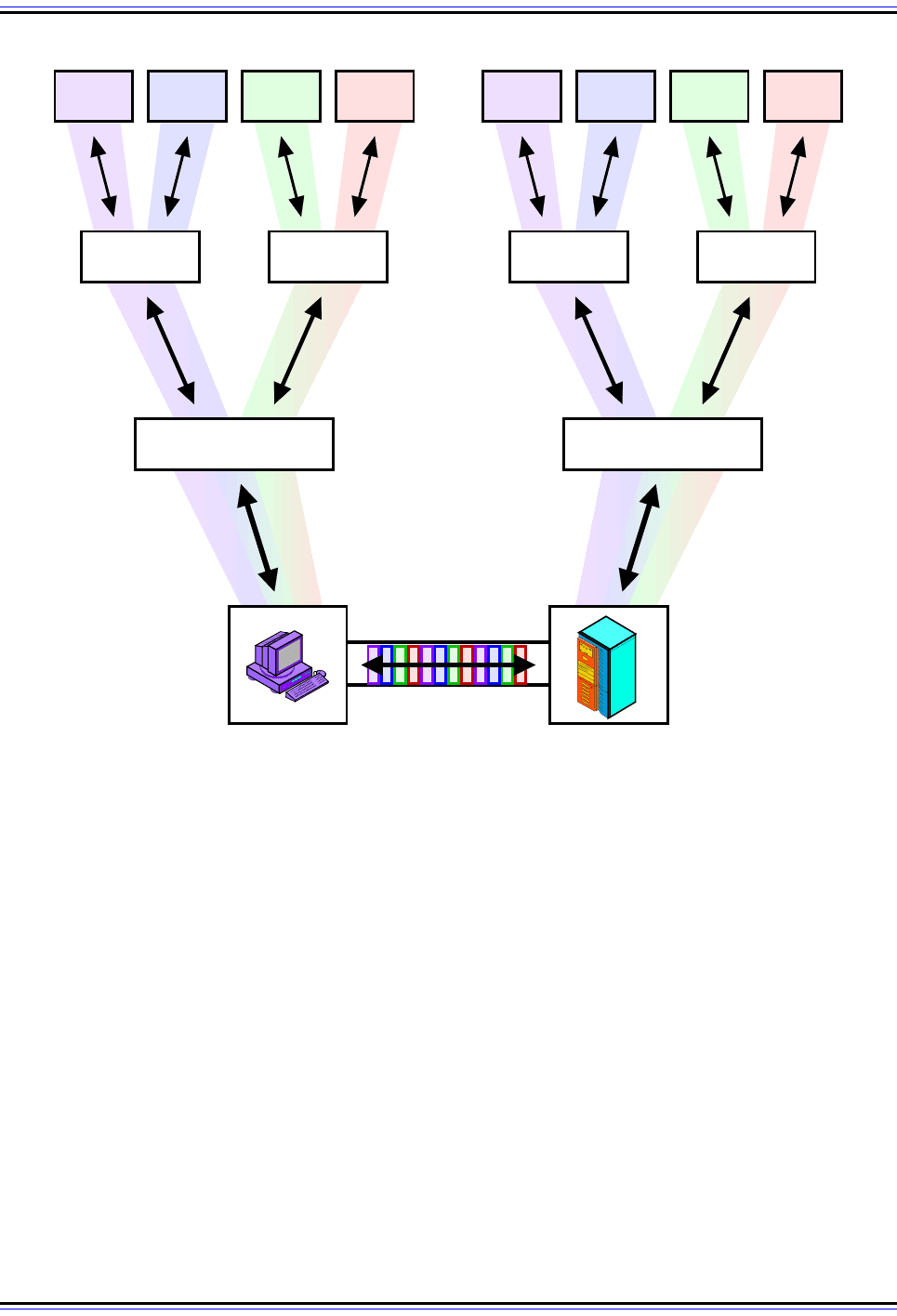
The TCP/IP Guide - Version 3.0 (Contents) ` 812 _ © 2001-2005 Charles M. Kozierok. All Rights Reserved.
TCP/IP Client Processes and Server Processes
There's another characteristic of TCP/IP software that is very important to understanding
how the transport layer and higher layers of the suite operate: it is generally asymmetric.
This means that when a TCP/IP application process on one computer tries to talk to an
application process on another computer, the two processes are usually not exactly the
same. They are instead complements of each other, designed to function together as a
team.
As I explained in the overview description of TCP/IP, most networking applications use a
client/server model of operation. This term can be used to refer to the roles of computers,
where a server is a relatively powerful machine that provides services to a large number of
Figure 197: Process Multiplexing and Demultiplexing In TCP/IP
In a typical machine running TCP/IP there are many different protocols and applications running simulta-
neously. This example shows four different applications communicating between a client and server machine.
All four are multiplexed for transmission using the same IP software and physical connection; received data is
demultiplexed and passed to the appropriate application. IP, TCP and UDP provide the means of keeping
distinct the data from each application.
Client Server
App #4App #3App #2App #1
TCP UDP
App #4App #3App #2App #1
TCP UDP
Internet Protocol Internet Protocol

The TCP/IP Guide - Version 3.0 (Contents) ` 813 _ © 2001-2005 Charles M. Kozierok. All Rights Reserved.
user-operated clients. It also applies to software. In this context, a client process is usually
one that runs on a client machine and initiates contact to perform some sort of function. A
server process usually runs on a hardware server, and listens for requests from clients and
responds to them.
The classic example of this is, of course, the World Wide Web. The WWW uses the
Hypertext Transfer Protocol (HTTP), a good example of an application protocol. A Web
browser is an HTTP client, normally running on an end-user client machine such as you are
probably using at this moment. It initiates an exchange of HTTP (Web) data by sending a
request to a Web (HTTP) server. A server process on that Web server hears the request
and replies either with the requested item(s)—a Web page or other data—or an error
message. The server is usually specifically designed to handle many incoming client
requests, and in many cases for little else.
Okay, I can practically see the impatient look on your face as you wonder to yourself: “why
is he telling me all of this in a section that is supposed to explain TCP and UDP ports”? The
answers will become clear shortly, I promise. I started here because the fact that many
application processes run simultaneously and have their data multiplexed for transmission
is the impetus for why higher-level addressing is a necessity in TCP/IP. The client/server
arrangement used by TCP/IP has an important impact on the way that ports are used and
the mechanisms for how they are assigned. The next two topics explore these concepts
more completely.
TCP/IP Ports: Transport Layer (TCP/UDP) Addressing
A typical host on a TCP/IP internetwork has many different software application processes
running concurrently. Each generates data that it sends to either TCP or UDP, which in turn
passes it to IP for transmission. This multiplexed stream of datagrams is sent out by the IP
layer to various destinations. Simultaneously, each device's IP layer is receiving datagrams
that originated in numerous application processes on other hosts. These need to be demul-
tiplexed, so they end up at the correct process on the device that receives them.
Multiplexing and Demultiplexing Using Ports
The question is: how do we demultiplex a sequence of IP datagrams that need to go to
many different application processes? Let's consider a particular host with a single network
interface bearing the IP address 24.156.79.20. Normally, every datagram received by the IP
layer will have this value in the IP Destination Address field. Consecutive datagrams
received by IP may contains a piece of a file you are downloading with your Web browser,
an e-mail sent to you by your brother, and a line of text a buddy wrote in an IRC chat
channel. How does the IP layer know which datagrams go where, if they all have the same
IP address?
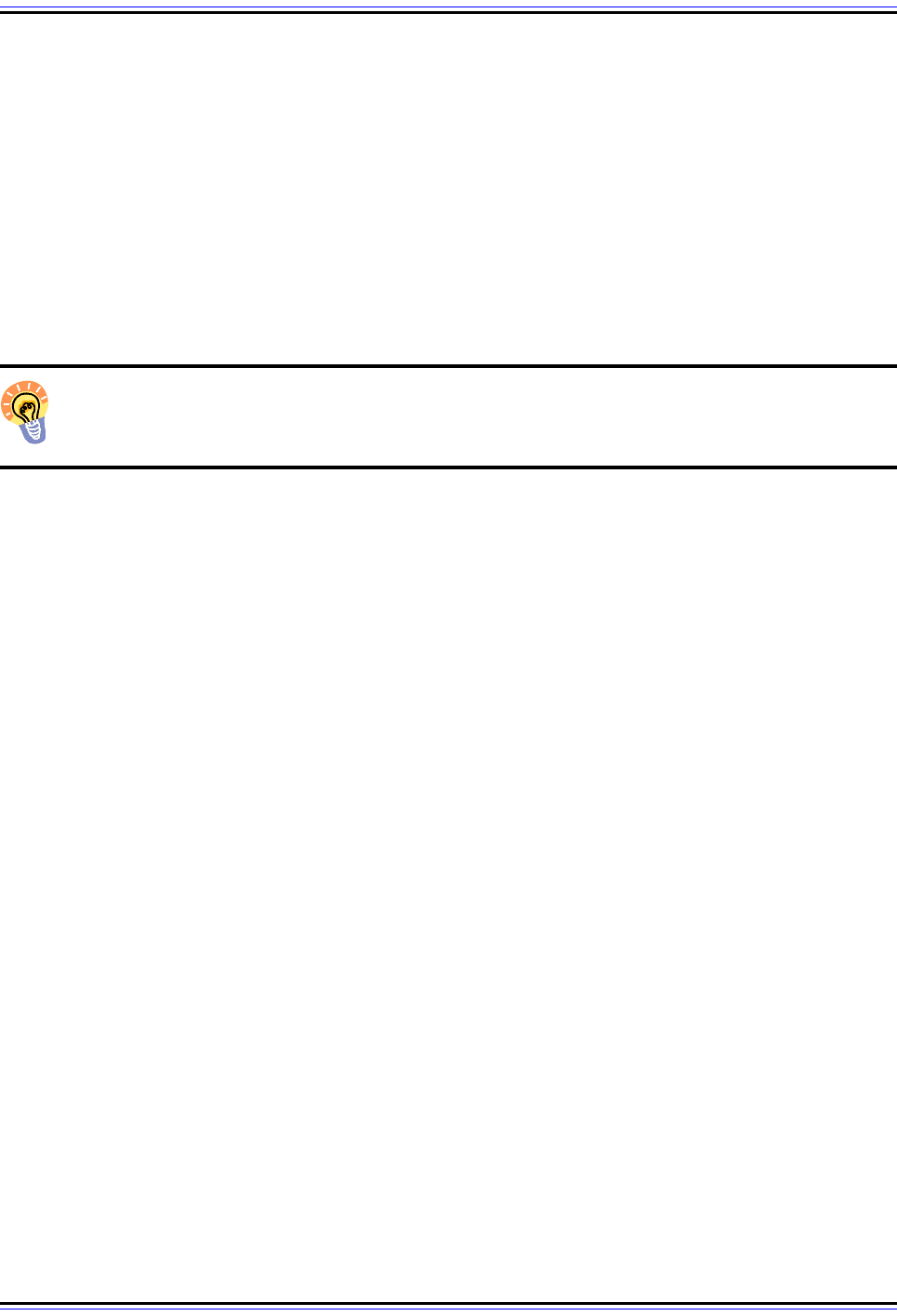
The TCP/IP Guide - Version 3.0 (Contents) ` 814 _ © 2001-2005 Charles M. Kozierok. All Rights Reserved.
The first part of the answer lies in the Protocol field included in the header of each IP
datagram. This field carries a code that identifies the protocol that sent the data in the
datagram to IP. Since most end-user applications use TCP or UDP at the transport layer,
the Protocol field in a received datagram tells IP to pass data to either TCP or UDP as
appropriate.
Of course, this just defers the problem to the transport layer: both TCP and UDP are used
by many applications at once. This means TCP or UDP must figure out which process to
send the data to. To make this possible, an additional addressing element is necessary.
This address allows a more specific location—a software process—to be identified within a
particular IP address. In TCP/IP, this transport layer address is called a port.
Key Concept: TCP/IP transport layer addressing is accomplished using TCP and
UDP ports. Each port number within a particular IP device identifies a particular
software process.
Source Port and Destination Port Numbers
In both UDP and TCP messages two addressing fields appear, for a Source Port and a
Destination Port. These are analogous to the fields for source address and destination
address at the IP level, but at a higher level of detail. They identify the originating process
on the source machine, and the destination process on the destination machine. They are
filled in by the TCP or UDP software before transmission, and used to direct the data to the
correct process on the destination device.
TCP and UDP port numbers are 16 bits in length, so valid port numbers can theoretically
take on values from 0 to 65,535. As we will see in the next topic, these values are divided
into ranges for different purposes, with certain ports reserved for particular uses.
One fact that is sometimes a bit confusing is that both UDP and TCP use the same range of
port numbers, and they are independent. So, in theory, it is possible for UDP port number
77 to refer to one application process and TCP port number 77 to refer to an entirely
different one. There is no ambiguity, at least to the computers, because as mentioned
above, each IP datagram contains a Protocol field that specifies whether it is carrying a
TCP message or a UDP message. IP passes the datagram to either TCP or UDP, which
then sends the message on to the right process using the port number in the TCP or UDP
header. This mechanism is illustrated in Figure 198.
In practice, having TCP and UDP use different port numbers is confusing, especially for the
reserved port numbers used by common applications. For this reason, by convention, most
reserved port numbers are reserved for both TCP and UDP. For example, port #80 is
reserved for the Hypertext Transfer Protocol (HTTP) for both TCP and UDP, even though
HTTP only uses TCP. We'll examine this in greater detail in the next topic.
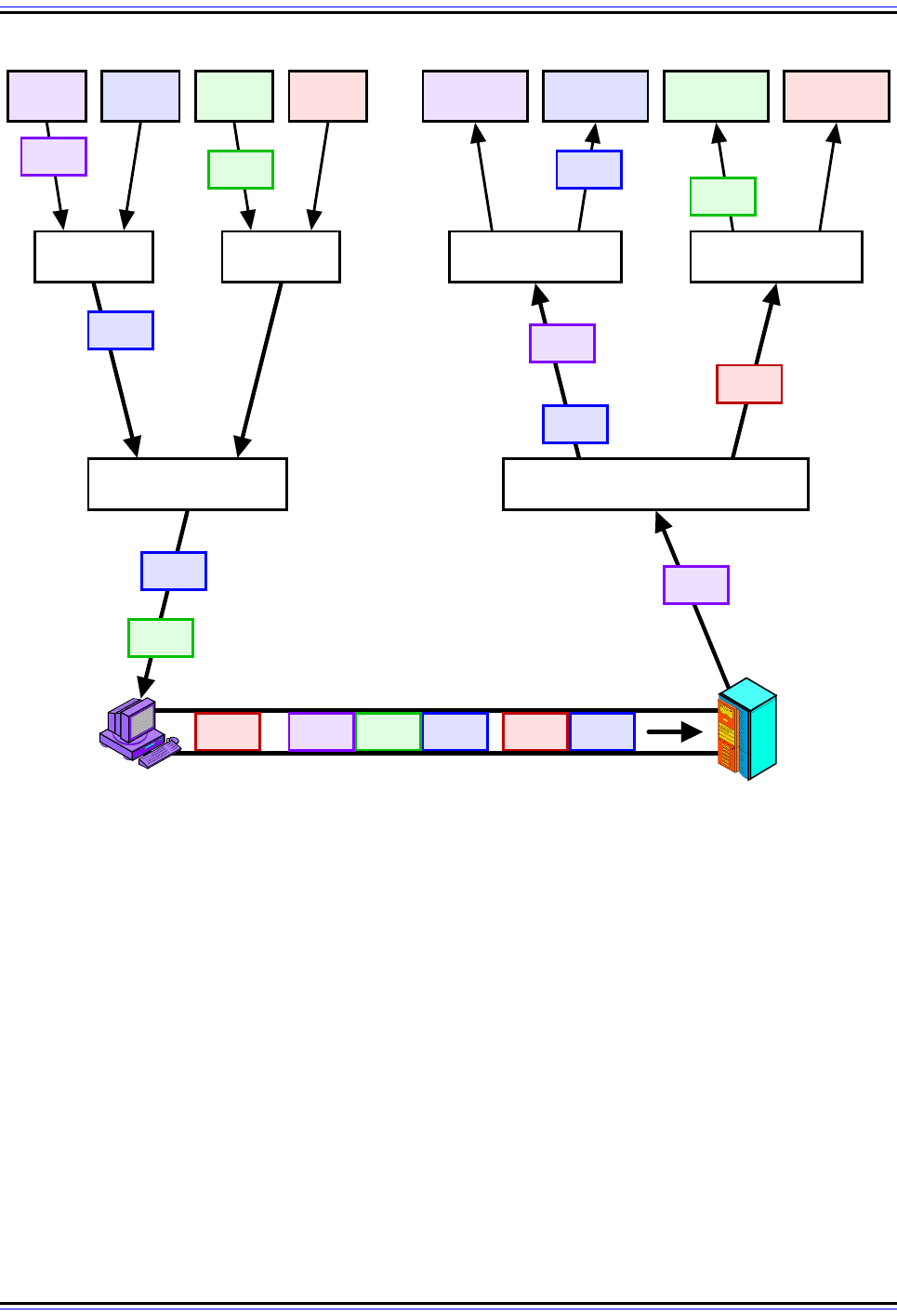
The TCP/IP Guide - Version 3.0 (Contents) ` 815 _ © 2001-2005 Charles M. Kozierok. All Rights Reserved.
Summary of Port Use for Datagram Transmission and Reception
So, to summarize, here's the basics of how transport-layer addressing (port addressing)
works in TCP and UDP:
Figure 198: TCP/IP Process Multiplexing/Demultiplexing Using TCP/UDP Ports
This is a more “concrete” version of Figure 197, showing how TCP and UDP ports are used to accomplish
software multiplexing and demultiplexing. Again here there are four different TCP/IP applications communi-
cating, but this time I am showing only the traffic going from the client to the server. Two of the applications are
using TCP and two UDP. Each application on the client sends messages using a specific TCP or UDP port
number. These port numbers are used by the server’s UDP and TCP software to pass the datagrams to the
appropriate application process.
TCP UDP
Internet Protocol
DHCP
UDP Por t 67
DNS
UDP Por t 53
HTTP
TCP Port 80
SMTP
TCP Port 25
Client Server
TCP UDP
Internet Protocol
DHCPDNSHTTPSMTP
TCP 80
UDP 53 TCP 80
UDP 53
UDP 53 TCP 80 UDP 67 TCP 80UDP 67
TCP 80
UDP 67
UDP 53
TCP 80
TCP 25
TCP 25
TCP 25
TCP 25
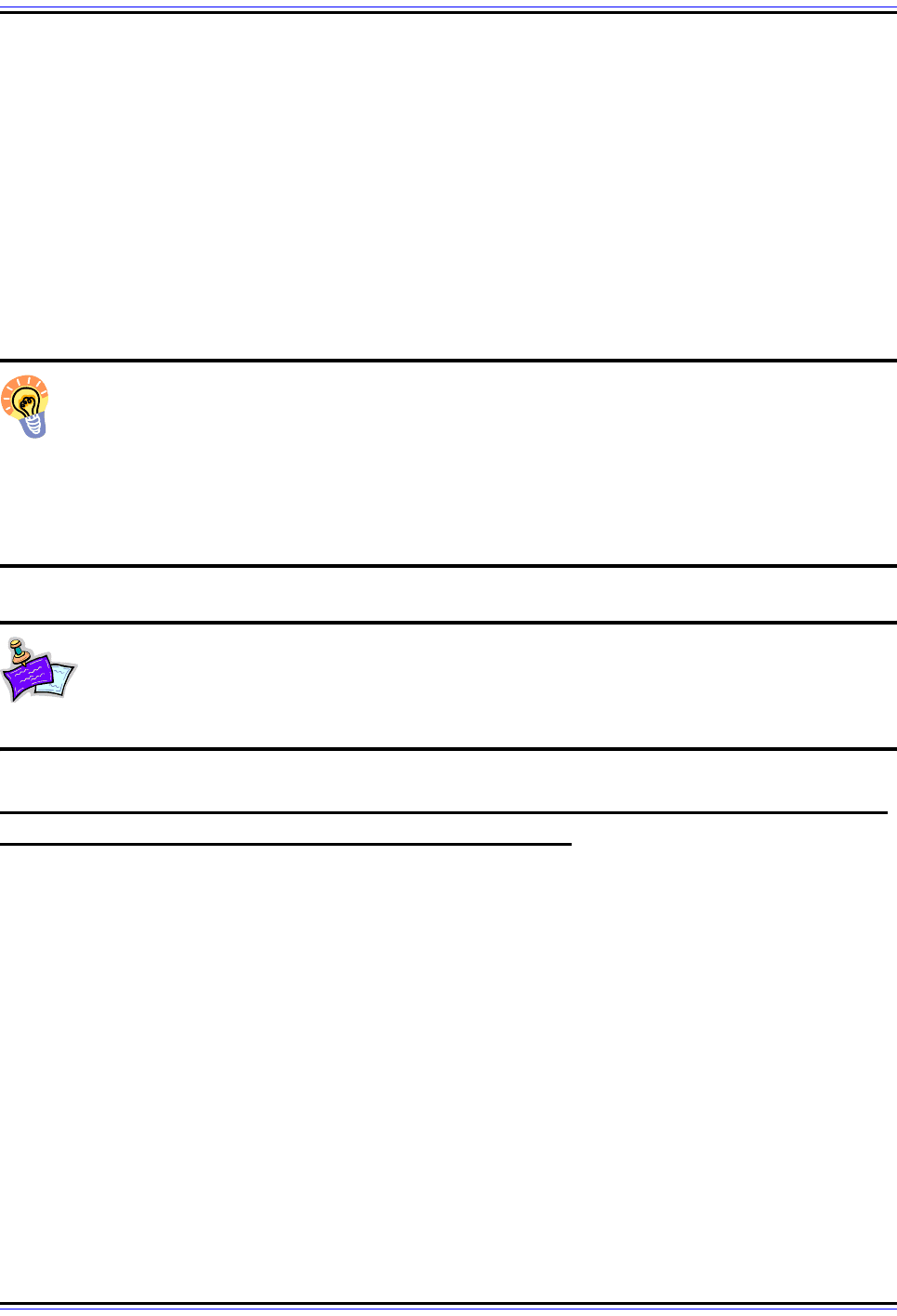
The TCP/IP Guide - Version 3.0 (Contents) ` 816 _ © 2001-2005 Charles M. Kozierok. All Rights Reserved.
☯ Sending Datagrams: An application specifies the source and destination port it
wishes to use for the communication. These are encoded into the TCP or UDP header,
depending on which transport layer protocol the application is using. When TCP or
UDP passes data to IP, IP indicates the protocol type appropriate for TCP or UDP in
the Protocol field of the IP datagram. The source and destination port numbers are
encapsulated as part of the TCP or UDP message, within the IP datagram's data area.
☯ Receiving Datagrams: The IP software receives the datagram, inspects the Protocol
field and decides to which protocol the datagram belongs (in this case, TCP or UDP,
but of course there are other protocols that use IP directly, such as ICMP). TCP or
UDP receives the datagram and passes its contents to the appropriate process based
on the destination port number.
Key Concept: Application process multiplexing and demultiplexing in TCP/IP is
implemented using the IP Protocol field and the UDP/TCP Source Port and Desti-
nation Port fields. Upon transmission, the Protocol field is given a number to indicate
whether TCP or UDP was used, and the port numbers are filled in to indicate the sending
and receiving software process. The device receiving the datagram uses the Protocol field
to determine whether TCP or UDP was used, and then passes the data to the software
process indicated by the Destination Port number.
Note: As an aside, I should point out that the term port has many meanings aside
from this one in TCP/IP. For example, a physical outlet in a network device is often
called a port. Usually one can discern whether the “port” in question refers to a
hardware port or a software port from context, but you may wish to watch out for this.
TCP/IP Application Assignments and Server Port Number Ranges: Well-
Known, Registered and Dynamic/Private Ports
The port numbers we discussed in the previous topic provide a method of transport-layer
addressing that allows many applications to use TCP and UDP simultaneously. By speci-
fying the appropriate destination port number, an application sending data can be sure that
the right process on the destination device will received the message. Unfortunately, there's
still a problem we have to work on before this addressing system will work.
The Problem: Identifying Particular Processes on A Server
To explain it, I need to go back to a familiar example: using the World Wide Web. We fire up
our Web browser, which is client software that sends requests using the Hypertext Transfer
Protocol (HTTP). We need to either know the IP address of the Web site we want to access,
or we may have the IP address supplied to us automatically using DNS. Once we have the
address, the Web browser can generate an HTTP message and send it to the Web site's IP
address.
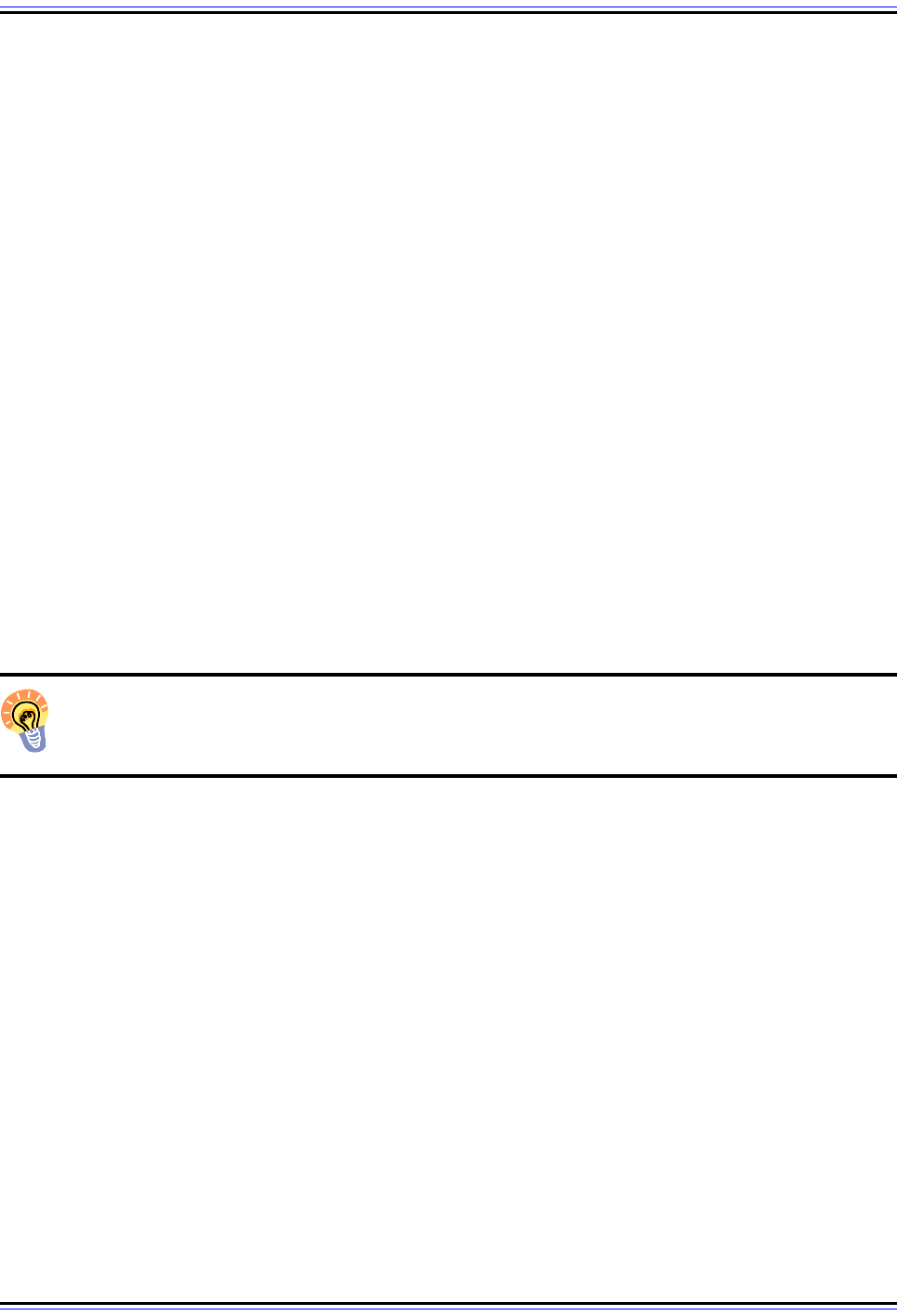
The TCP/IP Guide - Version 3.0 (Contents) ` 817 _ © 2001-2005 Charles M. Kozierok. All Rights Reserved.
This HTTP message is being sent not “just anywhere” on that IP address: it is intended for
the Web server process on the site we are trying to reach. The problem is: how does the
Web browser (client process) know which port number has been assigned to the server
process on the Web site? Port numbers can range from 0 to 65,535, which means a lot of
choices. And in theory, every Web site could assign a different port number to its Web
server process.
The Solution: Reserved Port Numbers
There are a couple of different ways to resolve this problem. TCP/IP takes what is probably
the simplest possible approach: it reserves certain port numbers for particular applications.
Each common application has a specific port number that is assigned to it for use by server
processes that listen for requests for that application and then respond to them. To avoid
chaos, the software that implements a particular server process normally uses the same
reserved port number on every IP device, so clients can find it easily.
In our example, the reserved port number for HTTP is 80. Every Web browser just “knows”
that Web sites are designed to listen for requests sent to port 80. They will thus use this
value in requests, to ensure the IP and TCP software on the Web browser direct these
HTTP messages to the Web server software. It is possible for a particular Web server to
use a different port number, but in this case, the user of the Web browser must be informed
of this number somehow, and must explicitly tell the Web browser to use it instead of the
default port number (80).
Key Concept: To allow client devices to more easily establish connections to TCP/IP
servers, server processes for common applications use universal server port
numbers that clients are pre-programmed to know to use by default.
TCP/UDP Port Number Ranges
For this system to work well, universal agreement on port assignments is essential. Thus,
this becomes another situation where a central authority is needed to manage a list of port
assignments that everyone uses. For TCP/IP, it is the same authority responsible for the
assignment and coordination of other centrally-managed numbers, including IP addresses,
IP Protocol numbers and so forth: the Internet Assigned Numbers Authority (IANA).
As we have seen, there are 65,536 port numbers that can be used for processes. But there
are also a fairly large number of TCP/IP applications, and the list grows every year. IANA
needs to carefully manage the port number “address space” to ensure that port numbers
are not wasted on protocols that won't be widely used, while also providing flexibility for
organizations that need to make use of obscure applications. To this end, the full spectrum
of TCP and UDP port numbers is divided into three ranges, as shown in Table 145.:
The existence of these ranges ensures that there will be universal agreement on how to
access a server process for the most common TCP/IP protocols, while also allowing flexi-
bility for special applications. Most of the TCP/IP applications and application protocols use
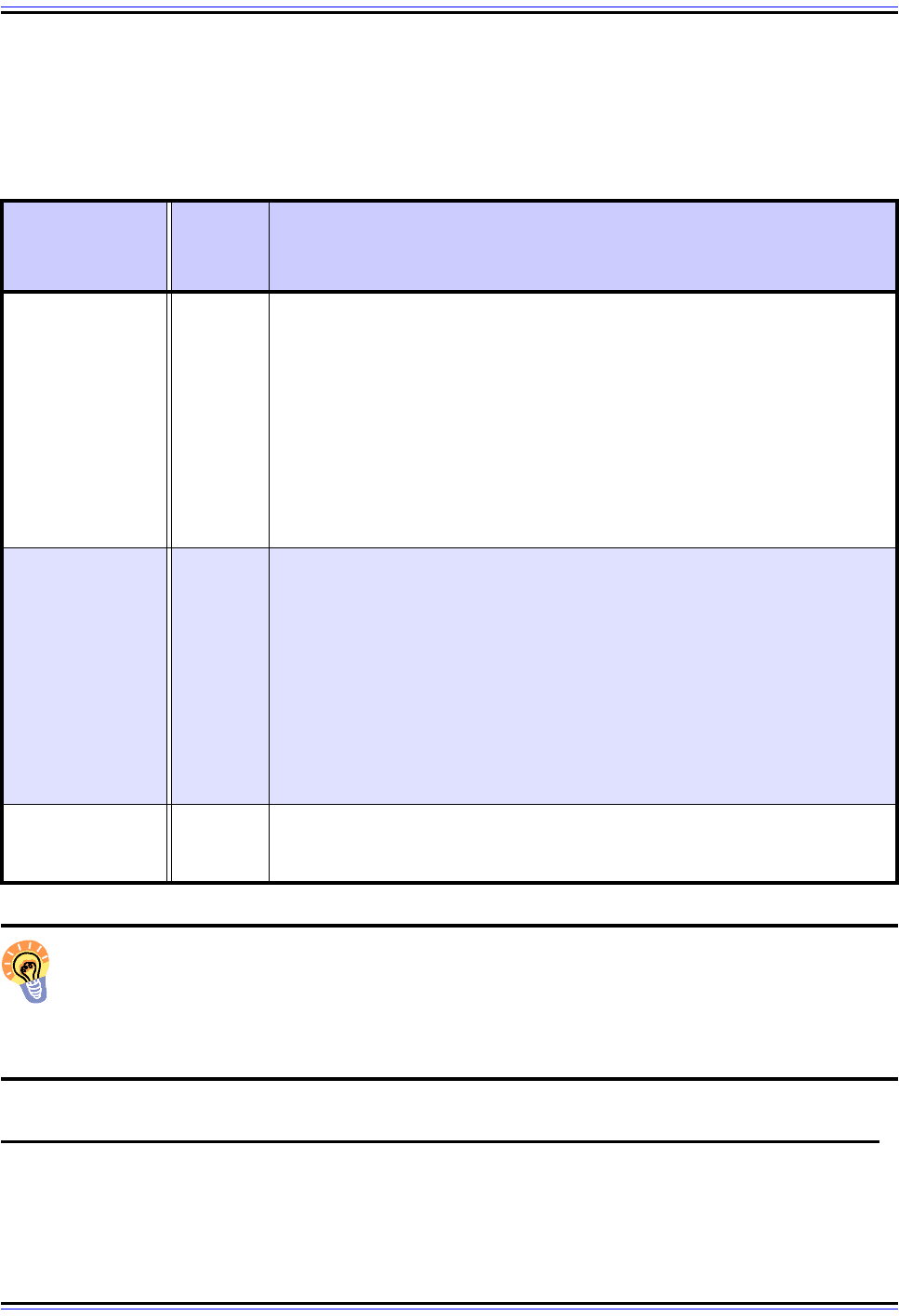
The TCP/IP Guide - Version 3.0 (Contents) ` 818 _ © 2001-2005 Charles M. Kozierok. All Rights Reserved.
numbers in the well-known port number range for their servers. These port numbers are not
generally used for client processes, but there are some exceptions. For example, port 68 is
reserved for a client using the Boostratp Protocol (BOOTP) or Dynamic Host Configuration
Protocol (DHCP).
Key Concept: Port numbers assignments are managed by IANA to ensure universal
compatibility around the global Internet. The numbers are divided into three ranges:
well-known port numbers used for the most common applications, registered port
numbers for other applications, and private/dynamic port numbers that can be used without
IANA registration.
TCP/IP Client (Ephemeral) Ports and Client/Server Application Port Use
The significance of the asymmetry between clients and servers in TCP/IP becomes evident
when we examine in detail how port numbers are used. Since clients initiate application
data transfers using TCP and UDP, it is they that need to know the port number of the
Table 145: TCP and UDP Port Number Ranges
Port Range
Name
Port
Number
Range
Description
Well-Known
(Privileged) Port
Numbers
0 to 1,023
These port numbers are managed by IANA and reserved for only the most
universal TCP/IP applications. The IANA assigns these port numbers only
to protocols that have been standardized using the TCP/IP RFC process,
that are in the process of being standardized, or that are likely to be
standardized in the future.
On most computers, these port numbers are used only by server
processes run by system administrators or privileged users. These
generally correspond to processes that implement key IP applications,
such as Web servers, FTP servers and the like. For this reason, these are
sometimes called system port numbers.
Registered
(User) Port
Numbers
1,024 to
49,151
There are many applications that need to use TCP/IP but are not specified
in RFCs, or are not so universally used that they warrant a worldwide well-
known port number. To ensure that these various applications do not
conflict with each other, IANA uses the bulk of the overall port number
range for registered port numbers. Anyone who creates a viable TCP/IP
server application can request to reserve one of these port numbers, and if
approved, the IANA will register that port number and assign it to the appli-
cation.
These port numbers are generally accessible by any user on a system and
are therefore sometimes called user port numbers.
Private/Dynamic
Port Numbers
49,152 to
65,535
These ports are neither reserved nor maintained by IANA. They can be
used for any purpose without registration, so they are appropriate for a
private protocol used only by a particular organization
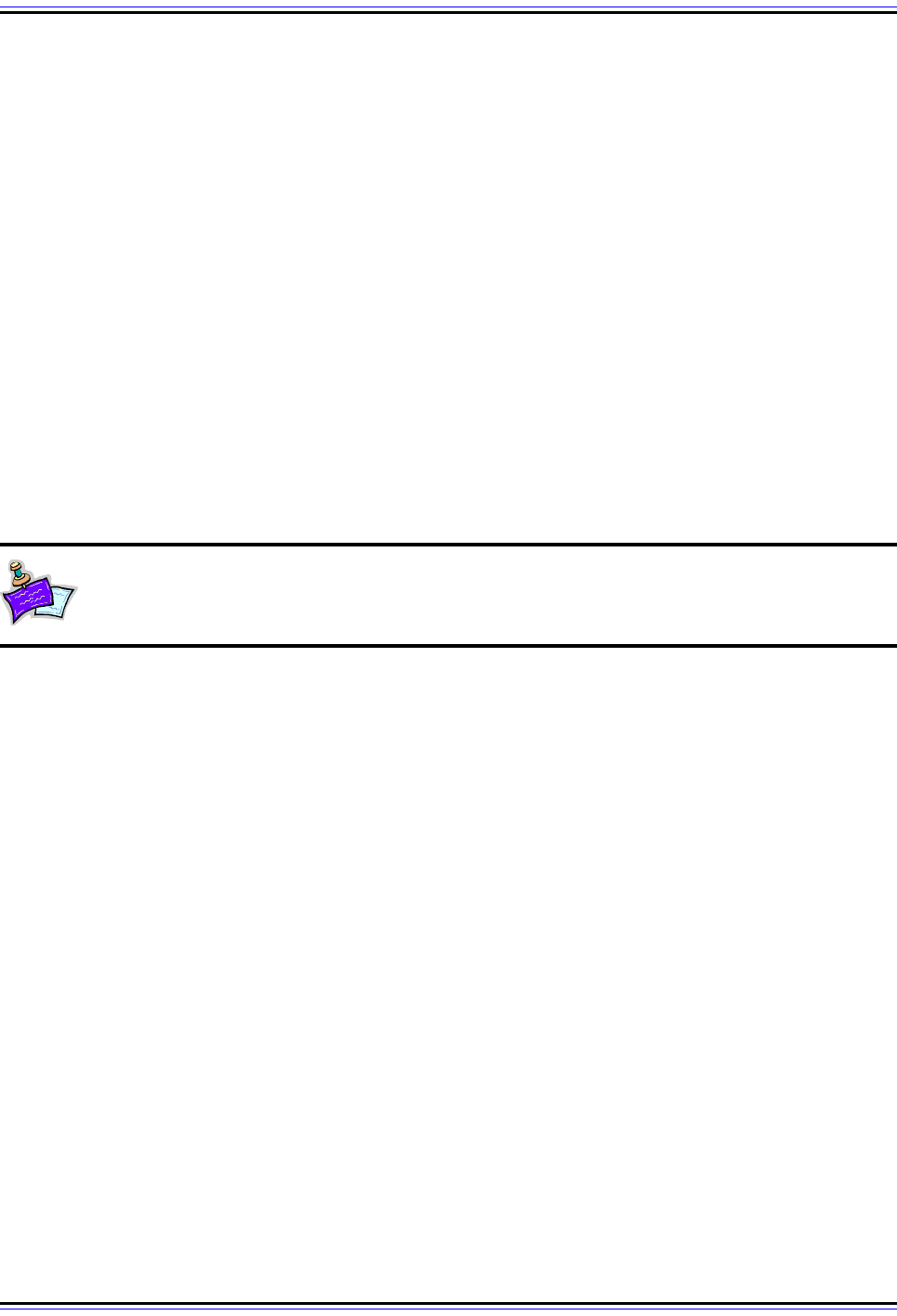
The TCP/IP Guide - Version 3.0 (Contents) ` 819 _ © 2001-2005 Charles M. Kozierok. All Rights Reserved.
server process. Consequently, it is servers that are required to use universally-known port
numbers. Thus, well-known and registered port numbers identify server processes. They
are used as the destination port number in requests sent by clients.
In contrast, servers respond to clients; they do not initiate contact with them. Thus, the
client doesn't need to use a reserved port number. In fact, this is really an understatement:
a server shouldn't use a well-known or registered port number to send responses back to
clients. The reason is that it is possible for a particular device to have both client and server
software of the same protocol running on the same machine. If a server received an HTTP
request on port 80 of its machine and sent the reply back to port 80 on the client machine, it
would be sending the reply to the client machine's HTTP server process (if present) and
not the client process that sent the initial request.
To know where to send the reply, the server must know the port number the client is using.
This is supplied by the client as the Source Port in the request, and then used by the server
as the destination port to send the reply. Client processes don't use well-known or regis-
tered ports. Instead, each client process is assigned a temporary port number for its use.
This is commonly called an ephemeral port number.
Note: Your $10 word for the day: ephemeral: “short-lived; existing or continuing for
a short time only.” — Webster's Revised Unabridged Dictionary.
Ephemeral Port Number Assignment
Ephemeral port numbers are assigned as needed to processes by the TCP/IP software.
Obviously, each client process running concurrently needs to use a unique ephemeral port
number, so the TCP and UDP layers must keep track of which are in use. These port
numbers are generally assigned in a pseudo-random manner from a reserved pool of
numbers. I say “pseudo-random” because there is no specific meaning to an ephemeral
port number assigned to a process, so a random one could be selected for each client
process. However, since it is necessary to reuse the port numbers in this pool over time,
many implementations use a set of rules to minimize the chance of confusion due to reuse.
Consider a client process that just used ephemeral port number 4,121 to send a request,
received a reply, and then terminated. Suppose we immediately reallocate 4,121 to some
other process. However, the server accessed by the prior user of port 4,121 for some
reason sent an extra reply. It would go to the new process, creating confusion. To avoid this,
it is wise to wait as long as possible before reusing port number 4,121 for another client
process. Some implementations will therefore cycle through the port numbers in to ensure
the maximum amount of time elapses between consecutive uses of the same ephemeral
port number.

The TCP/IP Guide - Version 3.0 (Contents) ` 820 _ © 2001-2005 Charles M. Kozierok. All Rights Reserved.
Key Concept: Well-known and registered port numbers are needed for server
processes since a client must know the server’s port number to initiate contact. In
contrast, client processes can use any port number. Each time a client process
initiates a UDP or TCP communication it is assigned a temporary, or ephemeral, port
number to use for that conversation. These port numbers are assigned in a pseudo-random
way, since the exact number used is not important, as long as each process has a different
number.
Ephemeral Port Number Ranges
The range of port numbers that is used for ephemeral ports on a device also depends on
the implementation. The “classic” ephemeral port range was established by the TCP/IP
implementation in BSD (Berkeley Standard Distribution) UNIX, where it was defined as
1,024 to 4,999, providing 3,976 ephemeral ports. This seems like a very large number, and
it is indeed usually more than enough for a typical client. However, the size of this number
can be deceiving. Many applications use more than one process, and it is theoretically
possible to run out of ephemeral port numbers on a very busy IP device. For this reason,
most of the time the ephemeral port number range can be changed. The default range may
be different for other operating systems.
Just as well-known and registered port numbers are used for server processes, ephemeral
port numbers are for client processes only. This means that the use of a range of addresses
from 1,024 to 4,999 does not conflict with the use of that same range for registered port
numbers as seen in the previous topic.
Port Number Use During a Client/Server Exchange
So, let's return to the matter of client/server application message exchange. Once assigned
an ephemeral port number, it is used as the source port in the client's request TCP/UDP
message. The server receives the request, and then generates a reply. In forming this
response message, it swaps the source and destination port numbers, just as it does the
source and destination IP addresses. So, the server's reply is sent from the well-known or
registered port number on the server process, back to the ephemeral port number on the
client machine.
Phew, confusing… quick, back to our example! ☺ Our Web browser, with IP address
177.41.72.6 wants to send an HTTP request to a particular Web site at IP address
41.199.222.3. The HTTP request is sent using TCP, with a Destination Port number of 80
(the one reserved for HTTP servers). The Source Port number is allocated from a pool of
ephemeral ports; let's say it's port 3,022. When the HTTP request arrives at the Web server
it is conveyed to port 80 where the HTTP server receives it. That process generates a reply,
and sends it back to 177.41.72.6, using Destination Port 3,022 and Source Port 80. The two
processes can exchange information back and forth; each time the source port number and
destination port number are swapped along with the source and destination IP addresses.
This example is illustrated in Figure 199.
